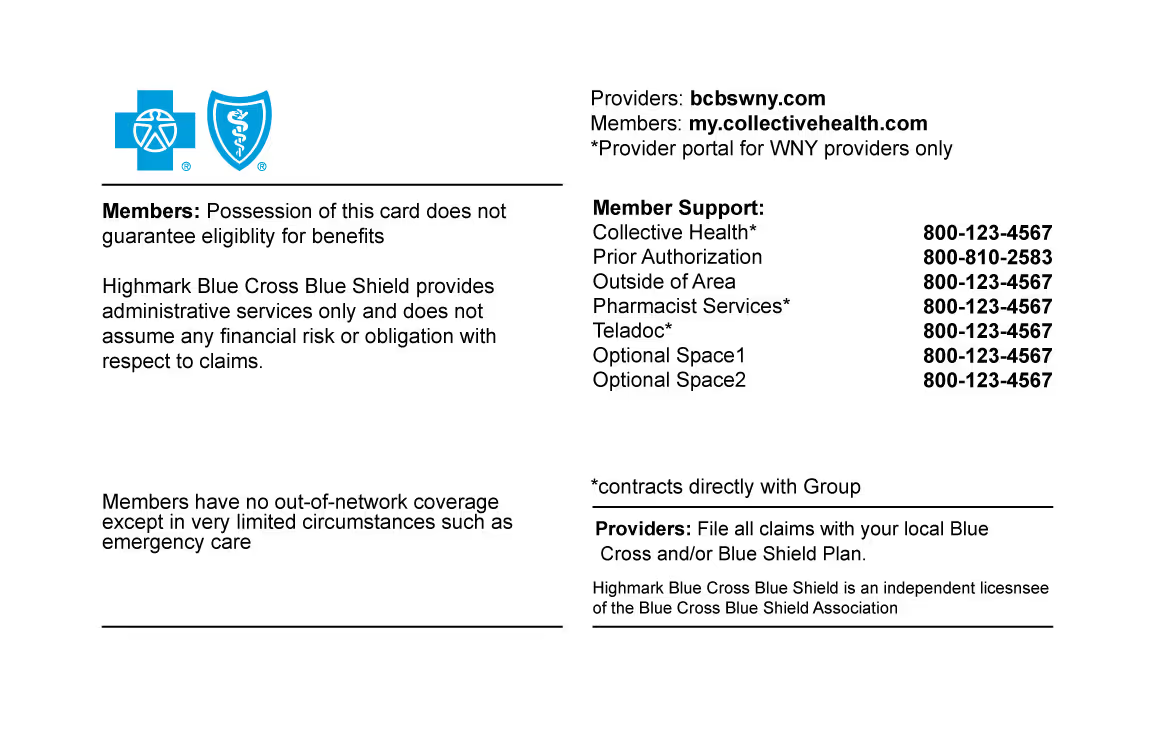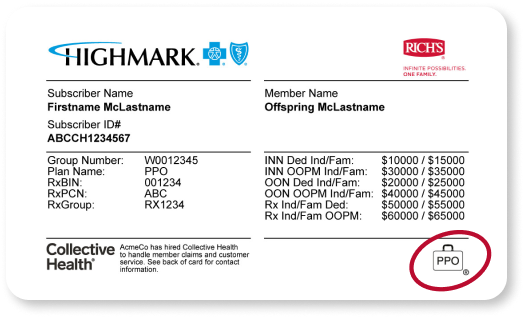Compare your options.


Plans at-a-glance.
Some plans cost more each month, but cover more when you need care. Others have lower monthly costs, but you’ll pay more out of pocket when you use them. Have a look.
paycheck
Weigh your options based on your expected needs. You can pay more each paycheck to spend less when you get care or pay less each paycheck and more at the time of treatment.
expenses
Utilize available options to help with out-of-pocket costs you may not have planned for, including voluntary benefits like Hospital Indemnity, Critical Illness, and pre-tax savings accounts (HSA/FSA).
Collective Health will be available 24/7 to help you find providers, check coverage, and understand your prescription costs.

See how the plans stack up.
Compare plans side by side—see what they cover, what they cost, and what sets them apart.



less later


Flexible Spending Account (FSA) - for eligible healthcare or dependent care expenses. HSA (Health Savings Account) - for qualified medical expenses if enrolled in an HDHP.
HSA (Health Savings Account) - for qualified medical expenses if enrolled in an HDHP. HRA (Health Reimbursement Arrangement) - an employer-funded account that reimburses you for qualified medical expenses.
Limited Purpose FSA (LPFSA) - can be used alongside an HSA (limited to covering eligible dental and vision expenses.)

embedded
embedded
embedded

embedded
embedded
embedded

(no deductible)
(no deductible)
(no deductible)










**90-day mail order out-of-pocket amounts can be found through ExpressScripts by Evernorth (ESI). Specialty medications not covered by mail order.
*** Kaiser (CA only) plan designs have slight variations from the plans outlined above. Click here for more information.
2026 Dental Plan Overview














2026 Vision Plan Overview












2026 costs per paycheck












Benefits of the BlueCard® Suitcase
The Highmark Blue Cross Blue Shield ID card’s suitcase symbol means access to doctors and hospitals across the country, all within the BCBS network.
Follow these steps:
- Search in-network providers using the link below.
- Select “Choose a location and plan” and enter your address, city or zip code and confirm.
- Select “Don’t know your alpha prefix? Browse a list of plans.”
- Choose Medical Network Name: PPOBlue and confirm.



Choosing coverage for real-world situations.
Everyone’s health needs are different. Here’s how to think through your options based on what life might look like for you—or your family.
Whether you’re planning for fertility treatments, pregnancy, adoption, or postpartum care, choosing the right health plan now can make every step easier and more affordable.
Do you prefer higher paycheck costs with lower out-of-pocket care—or lower paycheck costs with higher care expenses?
Compare plans using the chart above and download our tool to review what plan and coverage makes the most sense for you and your budget.
Does the plan cover the hospital or birth center you want, and what are the costs for delivery, C‑section, or newborn care?
Collective Health can assist you with searching the physician network or you can search the Highmark BCBS network by following these steps:
Visit: myproviderconnect.com/find-a-doctor
Select “Choose a location and plan” and enter your address, city or zip code. Then, confirm “Yes, this is correct.”
Select “Don’t know your alpha prefix? Browse a list of plans.” in small text below the card example and boxes.
Choose Medical Network Name: PPOBlue and confirm.
Are fertility medications, prenatal vitamins, and other prescriptions on the preferred drug list—and what will they cost?
Explore prescription coverage with the assistance of Collective Health.
Budgeting for copays, delivery costs, breast pumps, and baby supplies?
Consider a plan with a Flexible Spending Account or Health Savings Account (HSA) to help (see chart above).
In addition, supplemental health benefits, like hospital indemnity coverage, offer extra financial protection by paying a lump sum hospitalization stays.
If you’re adding a new baby to your benefits, should you consider setting aside money in a Dependent Care FSA (DCFSA) to help cover daycare or other childcare expenses with pre-tax dollars?
Here are a few advantages to using an FSA:
- Tax savings – The money you put in is pre-tax, so it lowers your taxable income.
- Covers child & adult care – You can use it for daycare, preschool, after-school programs, summer day camps, or care for elderly or disabled dependents.
- Helps offset big monthly costs – Since childcare and dependent care can be expensive, this account helps reduce the financial burden.
Is it time to update or create a will?
Explore estate planning via the MetLife Legal Plan.
Fertility struggles, pregnancy, and postpartum can be emotional. Would therapy or counseling be helpful for you or your family?
Learn more about our Confidential Assistance Program through Spring Health, with resources that support your mental health as you navigate your care journey.
Does the plan include fertility support, IVF coverage, pregnancy programs, or lactation consultations?
Rich’s medical plans provide coverage to support the family forming needs of our associates. You can explore available coverage with the assistance of Collective Health.

If you’re managing heart disease, recovering from a cardiac event, or focusing on prevention, the right health plan can help you access the care and support you need—without added stress.
Do you prefer higher paycheck costs with lower out-of-pocket care—or lower paycheck costs with higher care expenses?
Compare plans using the chart above and download our tool to review what plan and coverage makes the most sense for you and your budget
Are your cardiologists, surgeons, or other key providers in‑network?
Collective Health can assist you with searching the physician network or you can search the Highmark BCBS network by following these steps:
Visit: myproviderconnect.com/find-a-doctor
Select “Choose a location and plan” and enter your address, city or zip code. Then, confirm “Yes, this is correct.”
Select “Don’t know your alpha prefix? Browse a list of plans.” in small text below the card example and boxes.
Choose Medical Network Name: PPOBlue and confirm.
Does the plan cover the hospitals you’d turn to for urgent or intensive cardiac care?
The charts above show how the plans cover each of these options. Collective Health can also help you determine what's covered.
Are your heart medications on the preferred drug list, and what will they cost?
Explore prescription coverage with the assistance of Collective Health.
Will the plan support you with coverage for advanced treatments and specialized care, including cardiac care and transplants?
Explore the Blue Distinction Centers of Excellence program through Highmark with the help of Collective Health.
Would a Health Savings Account (HSA) or Flexible Spending Account (FSA) offset recurring costs for prescriptions, copays, and treatments?
Both an HSA and an FSA have advantages to helping offset recurring medical costs. Here are a few things to consider:
- HSA must be paired with a high-deductible health plan
- FSA does not require a certain medical plan
Key difference: If you need flexibility right away for frequent expenses, an FSA is helpful. If you want to build a long-term cushion for ongoing or future healthcare costs, an HSA is a useful option.
Would critical illness or hospital indemnity coverage provide extra financial protection if you face unexpected heart‑related events?
Explore supplemental insurance options with MetLife. Supplemental health benefits like critical illness or hospital indemnity coverage aren’t replacements for medical insurance, but they can provide extra financial protection, which is especially helpful for someone managing a chronic condition.
Heart health challenges can be stressful. Would therapy or counseling be helpful for you or your family?
Learn more about our Confidential Assistance Program through Spring Health, with resources that support your mental health as you navigate your care journey.
Looking for support to stay on track with healthy eating and exercise?
Personify Health makes it easy to track steps and nutrition while earning rewards for healthy habits. Connect your phone or favorite device, sync with apps like MyFitnessPal, or explore guided programs and recipes to build lasting wellness routines.

If you’re dealing with chronic pain, mobility issues, or recovering from an injury, the right health plan can make it easier to get the treatments, therapy, and support you need.
Do you prefer higher paycheck costs with lower out-of-pocket care—or lower paycheck costs with higher care expenses?
Compare plans using the chart above and download our tool to review what plan and coverage makes the most sense for you and your budget.
Are your orthopedists, rheumatologists, or other key providers in‑network?
Collective Health can assist you with searching the physician network or you can search the Highmark BCBS network by following these steps:
Visit: myproviderconnect.com/find-a-doctor
Select “Choose a location and plan” and enter your address, city or zip code. Then, confirm “Yes, this is correct.”
Select “Don’t know your alpha prefix? Browse a list of plans.” in small text below the card example and boxes.
Choose Medical Network Name: PPOBlue and confirm.
Does the medical plan provide coverage for hospital stays, urgent, or intensive care?
The charts above show how the plans cover each of these options.
Are your pain relievers, anti‑ inflammatories, or osteoporosis medications on the preferred drug list, and what will they cost?
Explore prescription coverage with the assistance of Collective Health.
Do you need help to pay for copays, braces, supports, and ongoing treatments?
Both an HSA and an FSA have advantages to helping offset recurring medical costs. Here are a few things to consider:
- HSA must be paired with a high-deductible health plan
- FSA does not require a certain medical plan
Key difference: If you need flexibility right away for frequent expenses, an FSA is helpful. If you want to build a long-term cushion for ongoing or future healthcare costs, an HSA is a useful option.
Does the plan include coverage for physical therapy, occupational therapy, or post‑surgical rehab?
Collective Health can assist you in determining which plans cover these therapies.
Living with chronic pain or mobility challenges can affect your mood. Would therapy or counseling be helpful for you or your family?
Learn more about our Confidential Assistance Program through Spring Health, with resources that support your mental health as you navigate your care journey.
Do you want extra financial protection if you face a fall, fracture, or surgery?
Explore supplemental accident or hospital indemnity insurance with MetLife. Supplemental health benefits like accident or hospital indemnity coverage aren’t replacements for medical insurance, but they can provide extra financial protection, which is especially helpful for someone managing a chronic condition.

If you’re facing cancer treatment or recovery, the right health plan can ensure you have access to the specialists, therapies, and support you need at every step.
Do you prefer higher paycheck costs with lower out-of-pocket care—or lower paycheck costs with higher care expenses?
Compare plans using the chart above and download our tool to review what plan and coverage makes the most sense for you and your budget.
Are your oncologists, surgeons, and key specialists in‑network and accepting new patients?
Collective Health can assist you with searching the physician network or you can search the Highmark BCBS network by following these steps:
Visit: myproviderconnect.com/find-a-doctor
Select “Choose a location and plan” and enter your address, city or zip code. Then, confirm “Yes, this is correct.”
Select “Don’t know your alpha prefix? Browse a list of plans.” in small text below the card example and boxes.
Choose Medical Network Name: PPOBlue and confirm.
Does the plan include major cancer centers or the hospitals you’d rely on for surgery, infusions, or complications?
Collective Health can assist you with learning more about Highmark BCBS’s Blue Distinction Network for cancer treatment options.
Are your chemotherapy drugs, targeted therapies, or anti‑nausea meds on the preferred drug list—and what will they cost?
Explore prescription coverage with the assistance of Collective Health.
Can you consult with providers for second opinions?
For second opinions contact, 2nd.MD or call 1.866.887.0712.
Consider a Health Savings Account (HSA) or Flexible Spending Account (FSA) to offset costs for medications, copays, and supportive care.
Both an HSA and an FSA have advantages to helping offset recurring medical costs. Here are a few things to consider:
- HSA must be paired with a high-deductible health plan
- FSA does not require a certain medical plan
Key difference: If you need flexibility right away for frequent expenses, an FSA is helpful. If you want to build a long-term cushion for ongoing or future healthcare costs, an HSA is a useful option.
Does the plan cover clinical trials, home infusion, palliative care, rehabilitation services, or wigs?
Explore options with the assistance of Collective Health.
A cancer diagnosis can be overwhelming. Would therapy or counseling be helpful for you or your family?
Learn more about our Confidential Assistance Program through Spring Health, with resources that support you as you navigate your care journey.
Do you want extra financial protection during treatment and recovery?
Explore supplemental accident, disability, or hospital indemnity insurance with MetLife. Supplemental health benefits like critical illness, accident, or hospital indemnity coverage aren’t replacements for medical insurance, but they can provide extra financial protection, which is especially helpful for someone managing a chronic condition.

If you’re managing a chronic condition, the right health plan can provide access to the care, guidance, and resources you need to stay on track and protect your long-term health.
Do you prefer higher paycheck costs with lower out-of-pocket care—or lower paycheck costs with higher care expenses?
Compare plans using the chart above and download our tool to review what plan and coverage makes the most sense for you.
Are your endocrinologist, dietitian, or other key providers (like cardiologists or weight‑management specialists) in‑network?
Collective Health can assist you with searching the physician network or you can search the Highmark BCBS network by following these steps:
Visit: myproviderconnect.com/find-a-doctor
Select “Choose a location and plan” and enter your address, city or zip code. Then, confirm “Yes, this is correct.”
Select “Don’t know your alpha prefix? Browse a list of plans.” in small text below the card example and boxes.
Choose Medical Network Name: PPOBlue and confirm.
Does the plan include coverage for the hospitals you’d rely on for complications or emergencies?
Explore coverage options with the assistance of Collective Health.
Are your daily medications (insulin, GLP‑1s, statins, etc.) on the preferred drug list—and what will they cost?
Explore prescription coverage with the assistance of Collective Health.
Can you connect with providers, nutritionists, or coaches virtually for check‑ins and follow‑ups?
Learn more about Teladoc from Collective Health.
Personify Health makes it easy to track steps and nutrition while earning rewards for healthy habits. Connect your phone or favorite device, sync with apps like MyFitnessPal, or explore guided programs and recipes to build lasting wellness routines.
Do you need help to pay for supplies (test strips, glucose monitors), copays, and treatments?
Consider a plan with a Flexible Spending Account (FSA) to help set aside funds to cover out-of-pocket costs. FSAs have advantages to helping offset recurring medical costs:
- Immediate access to funds – Your entire annual election is available at the start of the plan year, even if you haven’t contributed it all yet.
- Tax savings– Contributions lower your taxable income, helping stretch your paycheck.
- Covers many chronic care needs – Doctor visits, copays, prescriptions, and certain medical supplies are eligible.
- Predictable budgeting – Helps set aside money specifically for recurring medical costs throughout the year.
You can reach out to Collective Health for more details on what is covered by your medical plan along with prescription drug coverage.
Does the plan include weight‑management support, diabetes education, nutrition counseling, or fitness programs?
You can explore care options with the assistance of Collective Health. Personify Health can also support you in making lasting lifestyle changes.
Managing a chronic condition can be stressful. Would therapy or counseling be helpful for you or your family?
Learn more about our Confidential Assistance Program through Spring Health, with resources that support you as you navigate your care journey.
Do you want extra financial protection if complications lead to hospital stays or time off work?
Supplemental health benefits like critical illness, accident, or hospital indemnity coverage aren’t replacements for medical insurance, but they can provide extra financial protection, which is especially helpful for someone managing a chronic condition.

Act now to make sure you’re covered.
Mark your calendar and keep an eye on key dates! Open Enrollment opens October 27. Enrollment is required by November 7 to secure coverage through a Rich’s benefit plan.

We’re here to help.








